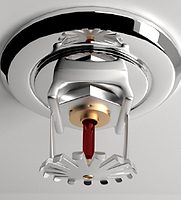Louisville Warehouse Fire

Before 7 a.m. on April 3, 2015, a fire occurred at Building 6 at the General Electric Appliance Park in Louisville, Kentucky. The fire grew out of control and ultimately destroyed the entire building. Fire investigators estimated the direct fire loss at $50 million to the building and $60 million to the contents.
Building 6 was built in the 1950s. In 1967, a large addition to the building was constructed. The building was fully sprinklered, containing the sprinkler systems originally installed during construction.
GE leased Building 6 to a parts vendor who was using the building as a warehouse for storage of appliance parts in racks. Of course, appliance parts have a significant amount of plastic content. It is not likely that a sprinkler system installed in 1967 consisting of ceiling-only sprinklers would have a chance against a fire in rack storage involving commodities with substantial plastic content.
During inspections in 2013 and 2014, insurance representatives identified the need to upgrade the sprinkler systems. It was reported that GE reported these deficiencies to the tenant with expectations that they would address the issue.
Sprinkler protection not adequate to deal with the hazard was not the only problem in this fire. As is so often the case with catastrophic fires, a multitude of bad things occurred simultaneously.
The 24 hours preceding the fire was a period of extreme rainfall in the Louisville area. As much as nine inches of rain is reported to have fallen during this period. Local fire departments had their hands full responding to incidents involving the flooding in the area. This possibly contributed to delays in response. There were also multiple lighting strikes in the area.
The official cause of the fire was undetermined. However, there was speculation that one of those lightning strikes could have been the cause. The roof in Building 6 was also leaking water in a many places, giving rise to the theory that an electrical short circuit caused by water leakage may have also been the cause of the fire.
As noted, in 2013 and 2014 insurance representatives informed GE that the hazards in the building were not properly protected. They also reported that the plant water supply was antiquated.
The plant water supply system dated back to the 1950s. The plant water system had eight pumps, arranged for manual starting. It is not clear if any of these were fire pumps. One pump was running during normal conditions, and additional pumps could be brought on-line manually by plant personnel as the demand increased.
In response to the concerns from the insurers, GE instituted a multi-million dollar fire protection improvement plan. Four of the eight pumps were out-of-service as they were being replaced as part of this program. It appears that at the time one pump was operating to meet the plant demands. When a plant operator attempted to start the three remaining pumps during the fire, the pumps failed to start. To make a bad situation worse, it appears that much of the water from the operating pump was being dumped through a pressure relief valve that was stuck in the open position.
The Appliance Park also had a system of water lines and fire hydrants supplied directly by the Louisville Water Company. Fire investigators reported that the GE plant was responsible for maintenance of the LWC water system on its campus. The responding fire department found the two fire hydrants nearest Building 6 were out of service. Checks after the fire found that most of these fire hydrants were not operational.
Now if all this bad karma was not enough, April 3, 2015 was Good Friday so Building 6 was operating with a reduced staff. GE also had only one plant operator present on site. At the time of the fire, he was at the boiler plant, about a mile from the water plant.
A sprinkler water flow alarm was reported just before 7 a.m. Alarms were monitored on the property and reported to the fire department via 911 after confirmation by plan security. The fire investigation reported there may have been a delay in notification of the fire department by plant security.
In addition to the more than $100 million in direct losses to the building and its contents, production at the Appliance Park was shut down for a week. Also, there have been several claims from neighboring properties related to clean-up from the massive amount of smoke generated by the fire.
The lessons that I think should be learned from this incident (none of which are surprising or new) are: 1) Provide protection to match the hazard. 2) Provide inspection, testing, and maintenance. 3) Provide fully automatic water supplies that can meet design demands. 4) Consider automatic notification of emergency forces where conditions warrant, and last but not least, 5) Water supply, water supply, water supply!
Samuel S. Dannaway, P.E., FSFPE, is a licensed fire protection engineer and mechanical engineer. He is vice president of Fire Protection Technology at Coffman Engineers Inc., a multidiscipline engineering firm with over 360 employees across eight offices. Sam can be reached at dannaway@coffman.com.





